Special Report
Countries With the Fastest Growing and Shrinking Militaries
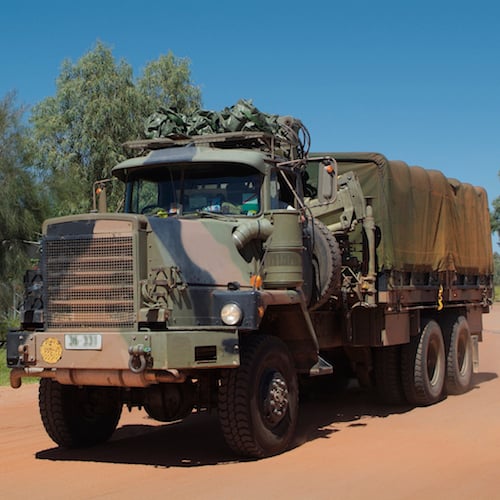
Published:
Last Updated:

The United States military remains the largest force on the planet. The superpower’s 2016 military expenditure of $611 billion was equivalent to approximately 36% of all global military spending. U.S. military spending was also up 1.7% from 2015, the first increase after five consecutive years of decline. A number of other countries substantially increased their military budgets last year, while a number of others cut spending substantially.
The world’s nations spent $1.67 trillion on their militaries in 2016, up slightly from 2015. Based on annual military expenditures estimated by the Stockholm International Peace Research Institute (SIPRI), 24/7 Wall St. reviewed the 15 countries with the largest one-year military expenditure increases and declines.
[in-text-ad]
Latvia, which continues to react to perceived threats from nearby Russia, leads the world with a military spending increase of 44%. Venezuela, after several years of economic crisis, shrunk its military budget by 56%, the most of any nation for which data is available.
Click here to see the countries with the fastest growing militaries.
Click here to see the countries with the fastest shrinking militaries.
In an interview with 24/7 Wall St., Nan Tian, researcher with the Arms and Military Expenditure Program at SIPRI, explained that “if there are security needs countries will spend more.” However, even if threats are perceived, economic limitations mean countries cannot increase military expenditures and may even be forced to cut spending.
With the precipitous decline in global oil prices — which remain near historic lows — national governments around the world continue to implement severe austerity measures. Of the 15 countries with the fastest shrinking militaries, 13 are oil-exporting nations.
Budget cuts of any kind need to be justified to the public. While in some nations security concerns are far greater than in others, Tian explained that “[t]he military is one of the easiest [government programs] to cut compared to say cutting health care or education.”
It is no coincidence that undiversified oil-exporting economies took the biggest hits in military budget cuts, and lack of resources is only part of the explanation. Military and oil industries often go hand-in-hand, as the need to protect energy assets has been in many cases the justification for military expansion.
“Arguments have been made by governments to say, ‘look we need to protect our resources,’ and one way is to spend more on military.”
Short-term spikes in military spending are also frequently a response to heightened regional tensions or a country’s ongoing involvement in a conflict.
As was the case in 2015, perceived threats from Russia, which used its enormous military might to annex Crimea in 2014, continue to trigger increased military budgets in Central European nations. The Baltic nations of Latvia, Lithuania, and Bulgaria are each among the countries with the fastest-growing defense budgets.
The Philippines is another example. The small island nation increased its military budget by 20% last year (25% the year before) due in large part to heightened tensions with China over fishing rights in the South China Sea.
To identify the countries with the fastest growing and fastest shrinking military budgets, 24/7 Wall St. reviewed increases in military expenditures from 2015 through 2016 as estimated by the Stockholm International Peace Research Institute (SIPRI) in its most recent annual “Trends in World Military Expenditure, 2016” report. We only considered countries with military expenditures of at least $100 million. Spending as a share of GDP and absolute spending figures for 2016 also came from SIPRI. Military expenditure data include all current and capital expenditure on:
We also considered 2016 per capita GDP from the International Monetary Fund (IMF). Gross domestic product figures are based on purchasing power parity (PPP) and are in current international dollars. Population data came from the World Bank and is for 2015.
These are the countries with the fastest growing (and shrinking) military expenditures.

15. Argentina
> Military spending 1 yr. change: +12%
> 2016 military spending: $5.2 billion
> Region: South America
> Population: 43.4 million
While military spending in South America as a whole fell by 7.5% in 2016, it substantially increased in Argentina, making it one of two countries, along with Colombia, on the continent to raise its military budgets last year. Argentina spent an estimated $5.2 billion on defense in 2016, 12.0% more than the prior year. The country’s military has not been involved in an international conflict since participating in the American-led coalition during the Gulf War in 1991, and it has mostly been involved in global peacekeeping efforts on behalf of the United Nations since. While President Mauricio Macri recently approved $2.5 billion in purchases to revamp military equipment, the military’s largest expense is personnel, comprising roughly 75% of the nation’s total defense budget.
[in-text-ad]
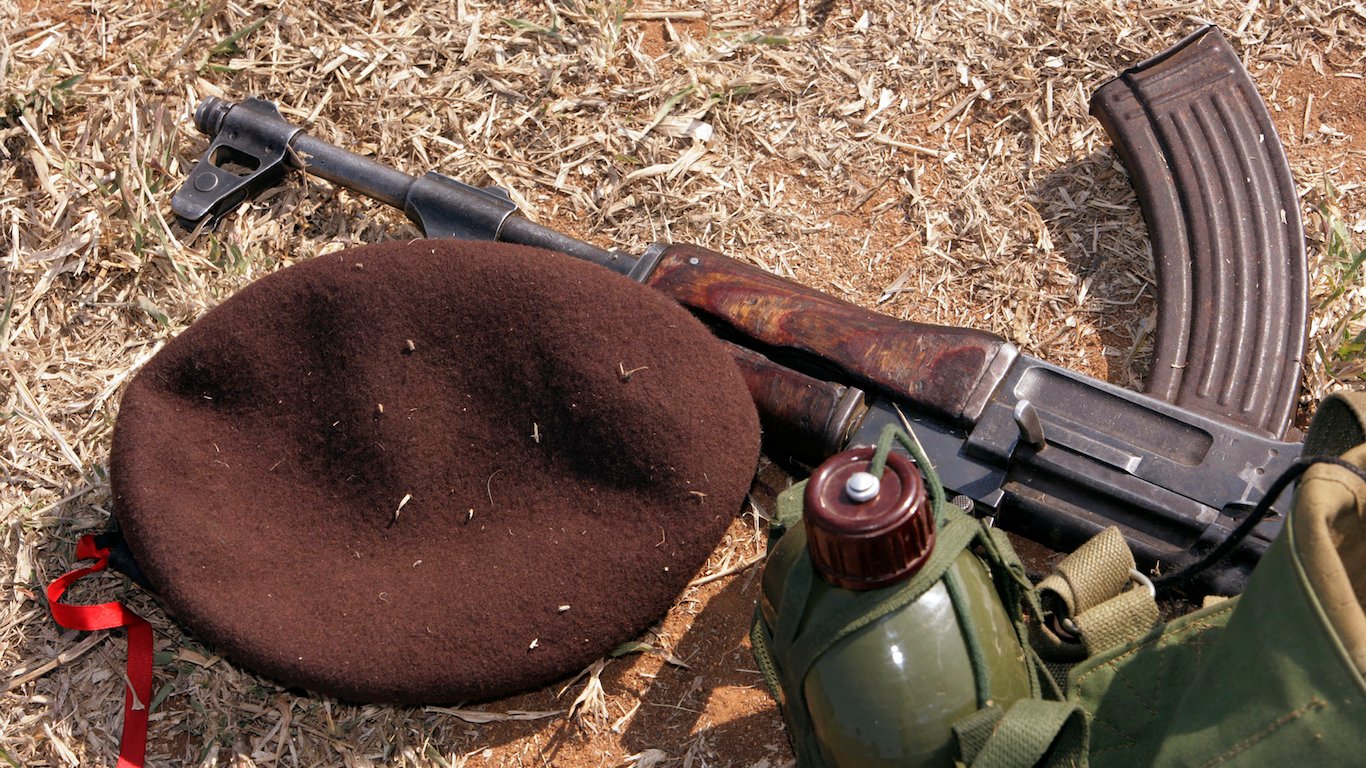
14. Mozambique
> Military spending 1 yr. change: +14%
> 2016 military spending: $112.0 million
> Region: Sub-Saharan Africa
> Population: 28.0 million
Largely attributable to decreased oil revenue at major exporters on the southern part of the continent, military spending in Africa fell by 1.3% in 2016. Mozambique is one of only a few countries on the continent to buck the trend. The sub-Saharan country spent $112 million on its military in 2016, a 14% increase over 2015 spending.
Investments in military often mean cuts in other social support domestic programs. Such cuts could be especially harmful in Mozambique as over half of the country’s 24 million residents live in poverty.

13. Trinidad and Tobago
> Military spending 1 yr. change: +14%
> 2016 military spending: $236.0 million
> Region: Caribbean
> Population: 1.4 million
While military spending in Central America and the Caribbean fell by 9.1% in 2016, Trinidad and Tobago increased its military budget by 14.0%. The twin island nation increased its military spending more than any other country in the region, and among the most of any country in the world. One reason for the increased defense spending may be the rising threat of domestic Islamic terrorism. According to a recent paper in the journal Studies in Conflict & Terrorism, Trinidad has one of the highest rates of radicalization of any Western nation, with an estimated number of Trinidadians having joined ISIS since 2013 ranging from 125 to 400 residents.
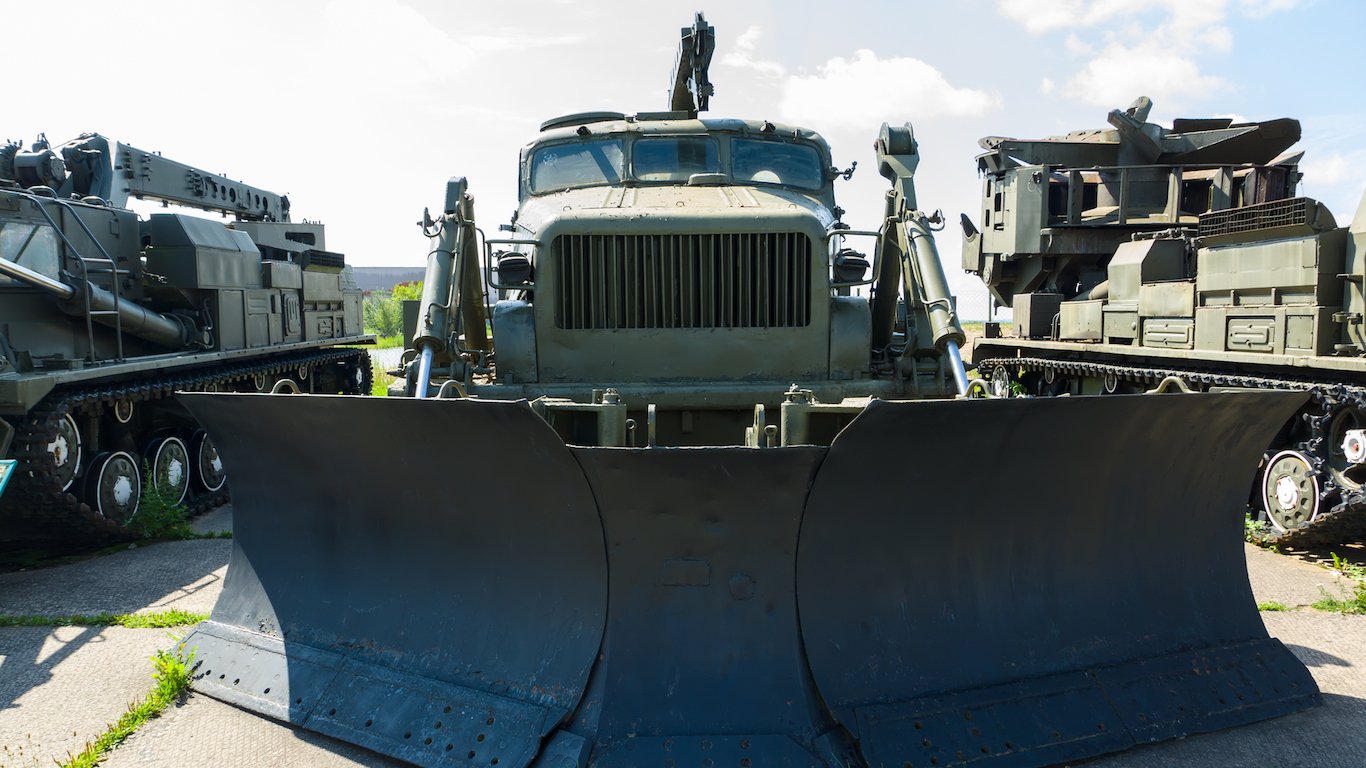
12. Bulgaria
> Military spending 1 yr. change: +14%
> 2016 military spending: $756.0 million
> Region: Eastern Europe
> Population: 7.2 million
In keeping with the trend across Eastern Europe, military spending climbed in Bulgaria in 2016. Bulgaria’s increased military investment is likely tied to recent calls from both President Barack Obama and President Donald Trump for NATO member states to spend at least 2% of their GDP on the military. Bulgaria spent only spent the equivalent of 1.32% of its GDP on the military in 2015.
Like many countries in the region, Bulgaria’s geopolitical loyalties are fraught. As a former satellite country of the Soviet Union, Bulgaria has important historic ties to Russia. However, the country’s newly elected President Rumen Radev has pledged his commitment to both NATO and the E.U., two alliances with interests that are often diametrically opposed to those of Russia.
[in-text-ad-2]

11. Togo
> Military spending 1 yr. change: +15%
> 2016 military spending: $82.0 million
> Region: Sub-Saharan Africa
> Population: 7.3 million
While military spending across sub-Saharan Africa fell by 3.1% in 2016, Togo increased its defense budget more than nearly any other country worldwide. The African nation spent $82.0 million on defense in 2016, a 15.0% increase from the year before. Other countries in the region, such as Mali and Senegal, also increased military spending substantially. Togo faces many of the threats common in Western Africa, including piracy and smuggling. Spending on the country’s military, the Togolese Armed Forces, amounts to approximately 1.7% of the country’s GDP, slightly more than the 1.2% average among sub-Saharan African nations.
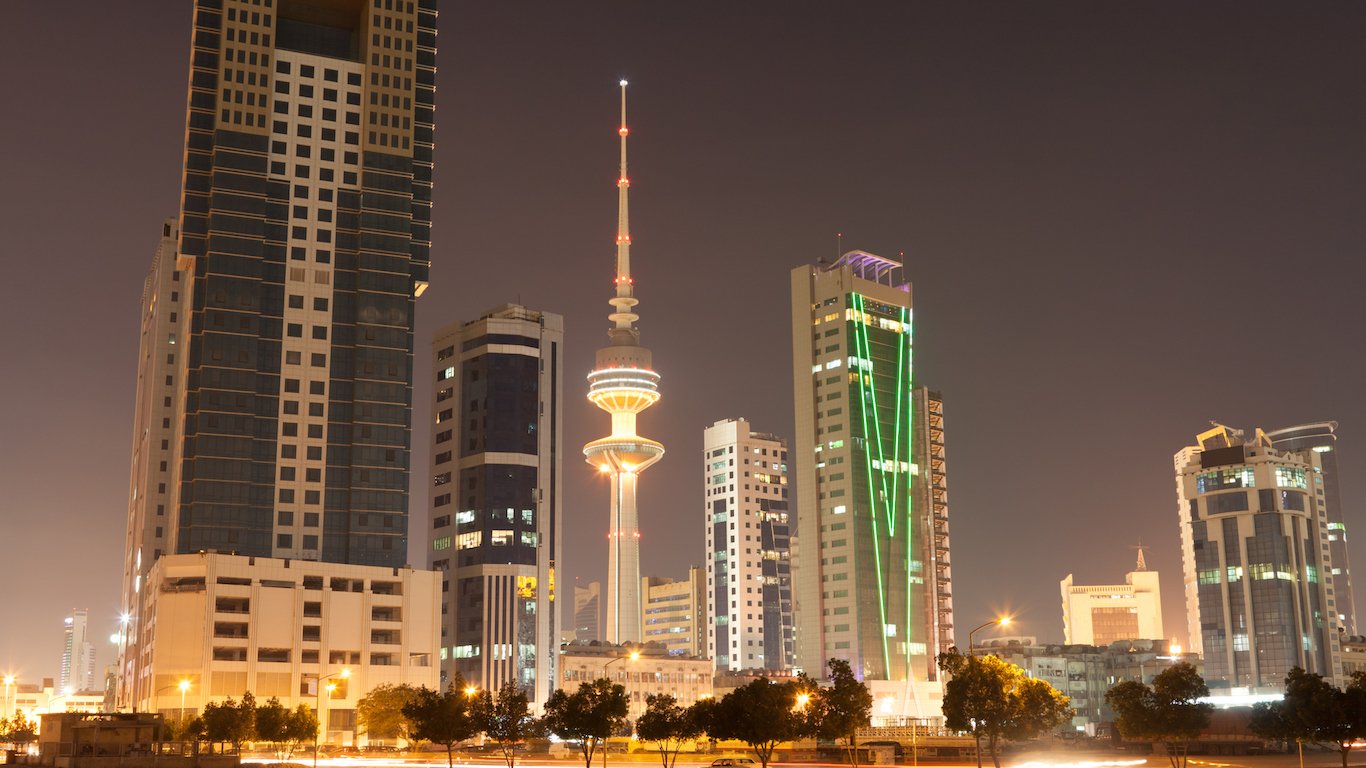
10. Kuwait
> Military spending 1 yr. change: +16%
> 2016 military spending: $6.6 billion
> Region: Western Asia
> Population: 3.9 million
The small, oil rich, Middle Eastern country of Kuwait spent $6.6 billion on its military in 2016, a 16% increase over the previous year. While the falling price of oil caused military spending to dip in a number of oil producing countries, Kuwait was one of only a few equipped to weather the economic blow.
Kuwait and American military history is closely entwined. In 1990, the Iraqi military, under the leadership of now-deceased former president Saddam Hussein, invaded Kuwait. The act of aggression prompted U.S. intervention under the direction of President George H.W. Bush.
The conflict, known as Operation Desert Storm, successfully drove the Iraqi army from Kuwait.
[in-text-ad]

9. Gabon
> Military spending 1 yr. change: +16%
> 2016 military spending: $203.0 million
> Region: Sub-Saharan Africa
> Population: 1.7 million
Gabon is one of several sub-Saharan African oil-export nations to increase military spending in the face of falling oil revenues. Despite the increase, Gabon’s military spending remains well below that of most countries reviewed. Additionally, the majority of the dozen other sub-Saharan nations spend more on their military than Gabon.
Low military spending partially reflects the military’s relatively low priority in the country. As of 2015, Gabon’s military spending equalled only 1.2% of GDP, below all but two of the 12 other nations reviewed in sub-Saharan Africa.

8. Iran
> Military spending 1 yr. change: +17%
> 2016 military spending: $12.7 billion
> Region: Southern Asia
> Population: 79.1 million
One of the dominant military powers in the Middle East, Iran spent $12.7 billion on its military in 2016, up 17% from the previous year.
Iran’s increased military spending is a cause for concern in many countries around the world, including the United States. This month, Secretary of State Rex Tillerson referred to the Middle Eastern country as “the world’s leading sponsor of terrorism.” The country is believed to be spending billions to prop up the regime of Bashar Al-Assad in Syria, a key strategic ally to the terrorist organization, Hezbollah. The Trump administration is currently reviewing the agreement made under the Obama administration that lowered Iran’s nuclear capability and lifted the long-time nuclear-related sanctions on the country. Iran’s increased military spending was partially made possible by the easing of sanctions that resulted from the nuclear deal.

7. Senegal
> Military spending 1 yr. change: +17%
> 2016 military spending: $254.0 million
> Region: Sub-Saharan Africa
> Population: 15.1 million
A longstanding force of stability in the region, Senegal is ramping up military spending. The country spent $254 million on its military in 2016, up 17% from the previous year.
Senegal’s military has been sent on peacekeeping missions to the Democratic Republic of the Congo, Liberia, and Kosovo. Earlier this year, the country sent troops into The Gambia as part of a regional coalition to help remove President Yahya Jammeh from power. Jammeh refused to step down after losing the most recent presidential election.
[in-text-ad-2]
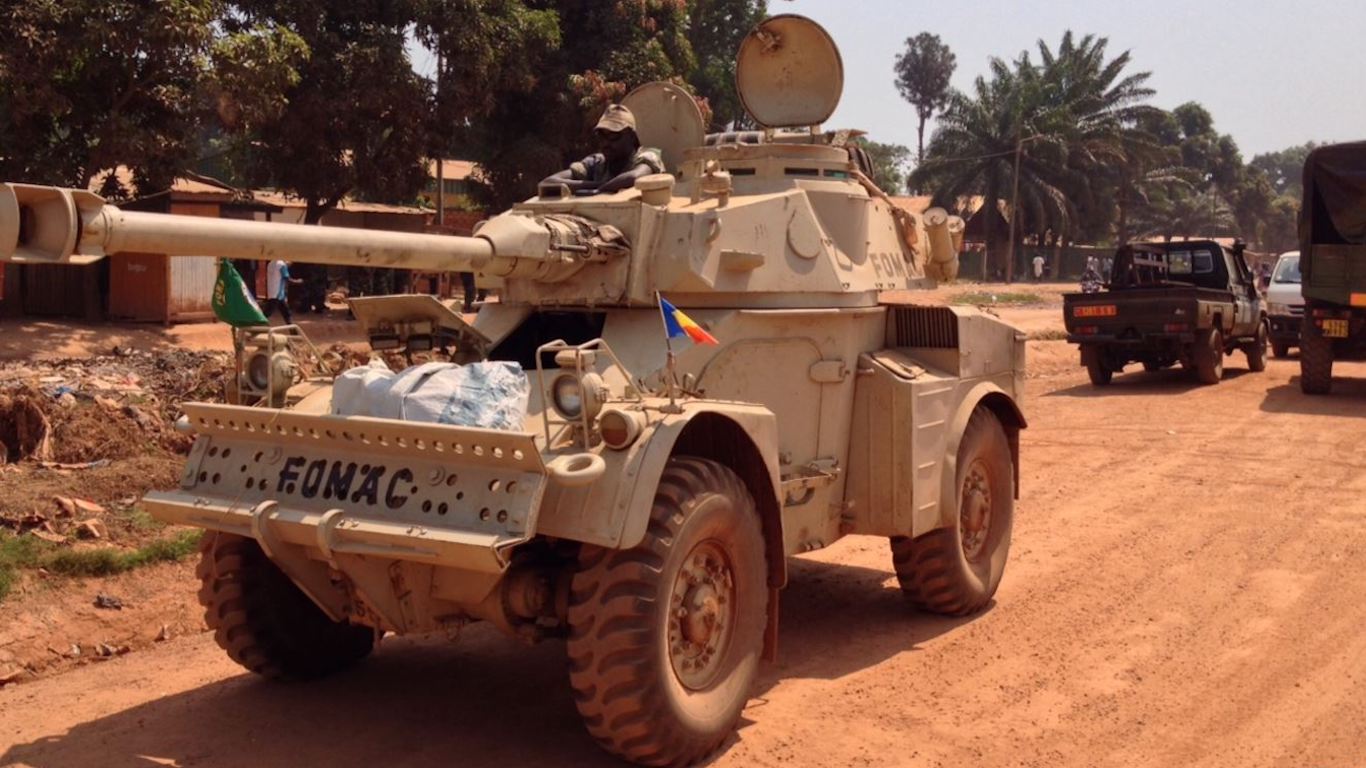
6. Chad
> Military spending 1 yr. change: +18%
> 2016 military spending: $267.0 million
> Region: Sub-Saharan Africa
> Population: 14.0 million
Since gaining independence from France in 1960, Chad has been plagued by instability and internal violence, with fighting between Muslims in the north and Christians in the south. The Chadian military is largely dedicated to domestic conflicts, combating Sudanese-backed rebels within the nation’s borders. While sub-Saharan Africa as a whole spent 3.6% less on defense in 2016 than in 2015, Chad increased military spending by 18.0%. Chad’s military budget amounts to 2.0% of the country’s GDP, more than the 1.2% average military spending among sub-Saharan African nations.
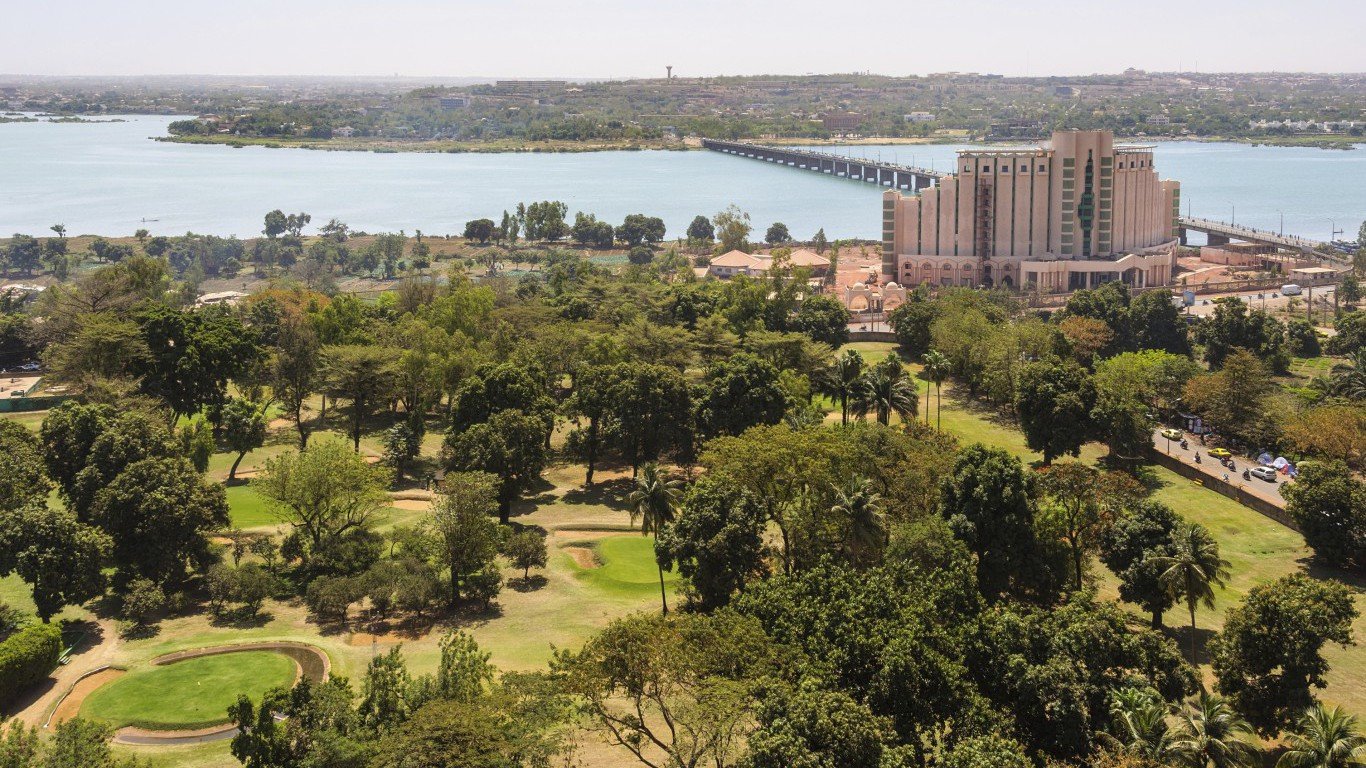
5. Mali
> Military spending 1 yr. change: +18%
> 2016 military spending: $369.0 million
> Region: Sub-Saharan Africa
> Population: 17.6 million
Violent uprisings by various militant groups in recent years in northern Mali have led to instability throughout the country. The Mali government has relied since 2013 on France, its former colonial ruler, to help maintain order. The country is currently in a state of emergency that has been in effect since an Al-Qaeda affiliated group attacked a hotel in 2015, killing 20 people.
In response to these rising threats, the Mali government approved one of the largest increases in military expenditure of any country. The sub-Saharan nation spent $369 million on its military in 2016, more than most other countries in the region and 18% more than the year before.
[in-text-ad]
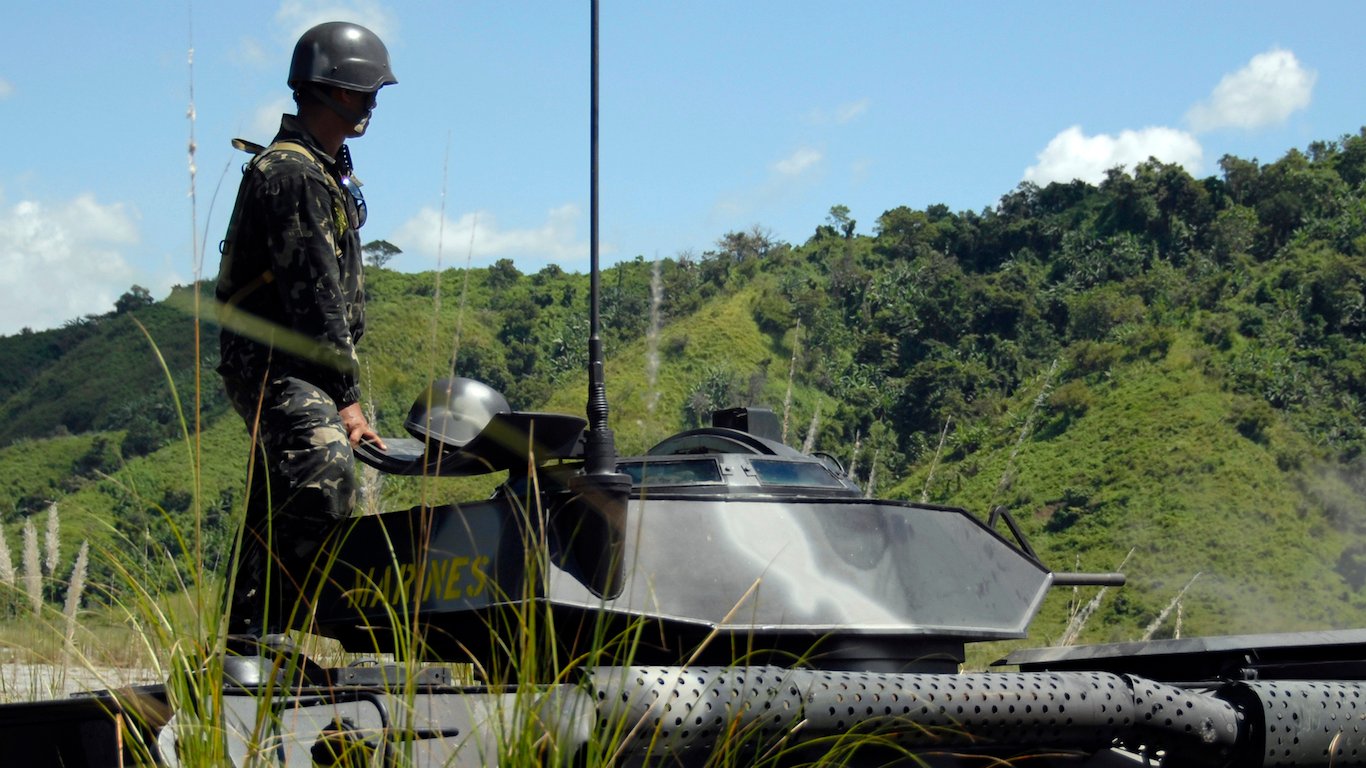
4. Philippines
> Military spending 1 yr. change: +20%
> 2016 military spending: $3.9 billion
> Region: Southeast Asia
> Population: 100.7 million
The Philippines spent $3.9 billion on defense in 2016, a 20% increase over 2015. The hike is part of an overall trend of increased military spending across Southeast Asia, where defense spending rose 5.1% last year. According to Philippine Defense Secretary Delfin Lorenzana, military spending will likely continue to increase as insurgency, natural disaster, and numerous territorial disputes with neighboring countries demand greater resources. In addition, under the provisions of the 2012 Armed Forces of the Philippines Modernization Act, the Pacific Island nation must steadily increase the size of its military.
While military spending accounts for roughly 1.3% of Philippines’ GDP, Lorenzana plans on dedicating some 2.4% of total GDP to defense in future budgets — roughly in line with the 2.3% average spending among all South Asian nations.

3. Lithuania
> Military spending 1 yr. change: +35%
> 2016 military spending: $636.0 million
> Region: Eastern Europe
> Population: 2.9 million
Lithuania is one of many Central European countries to substantially increase military spending in 2016. Lithuania spent $636.0 million on defense in 2016, a 35% increase from the year prior. Like much of the Baltic region, the spending hike is partially a response to Russian military buildup, particularly since the 2014 annexation of Crimea. Russia spent $69.2 billion on defense in 2016, a 5.6% increase from 2015 and an 87.0% increase from 2009. While Lithuania spends roughly 1.1% of GDP on defense, the country’s parliament has announced its intentions to increase defense spending beyond the 2% expected of NATO member countries in the near future. Russian military spending was 5.3% of its GDP in 2016, the seventh largest military budget on Earth.
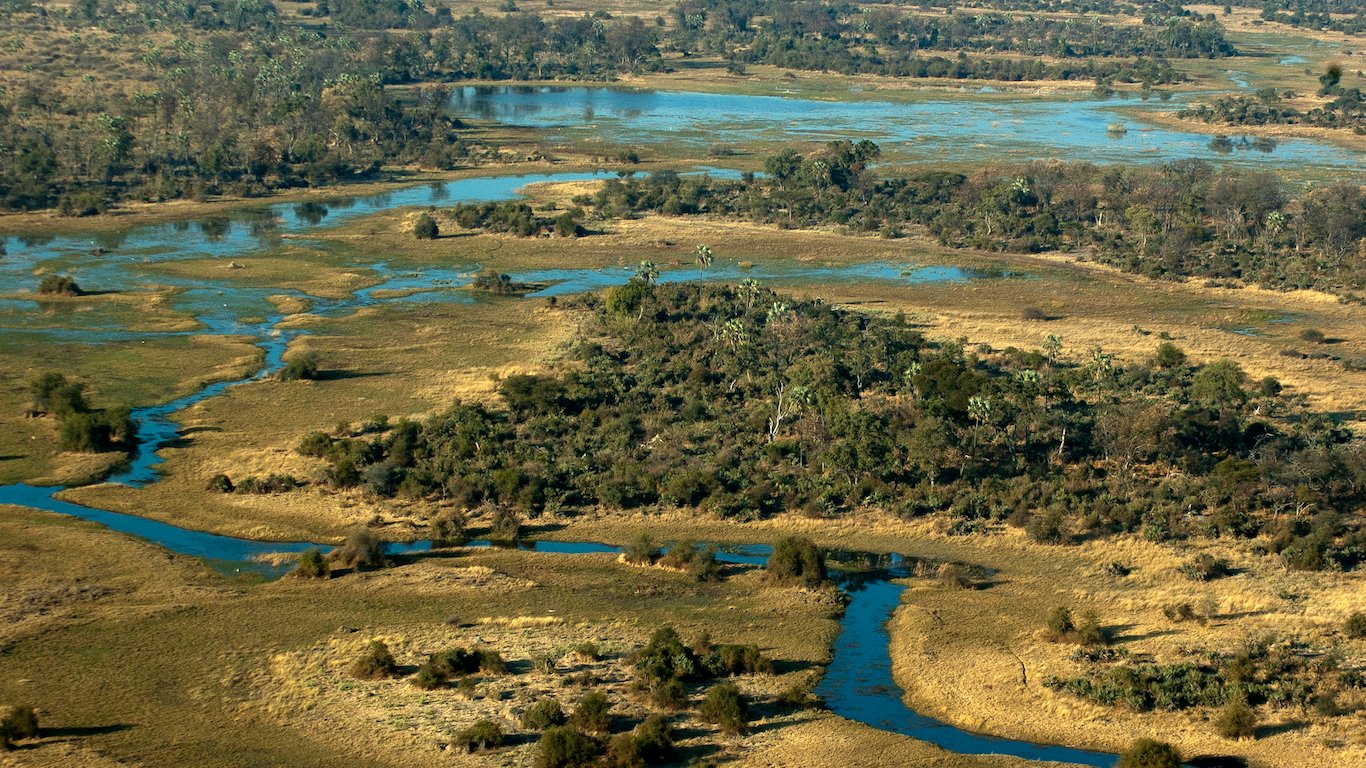
2. Botswana
> Military spending 1 yr. change: +40%
> 2016 military spending: $515.0 million
> Region: Sub-Saharan Africa
> Population: 2.3 million
Botswana is notable as one of Africa’s most stable countries with five decades of uninterrupted democracy. Despite the lack of armed conflict in its past, the country increased its military spending in 2016 more than any other country on the continent. The increase is part of a modernization effort by the Botswana Defence Force, which is set to procure an air defense missile system from France, jet fighters from South Korea, and other military hardware.
According to the Botswana newspaper Sunday Standard, experts believe the 40% increase in military spending is unwarranted given the low level of threat against the country. Other news outlets have also criticized the spending hike, accusing President Ian Khama of inciting an arms race in the region and growing the military to benefit family members through lucrative defense contracts.
[in-text-ad-2]
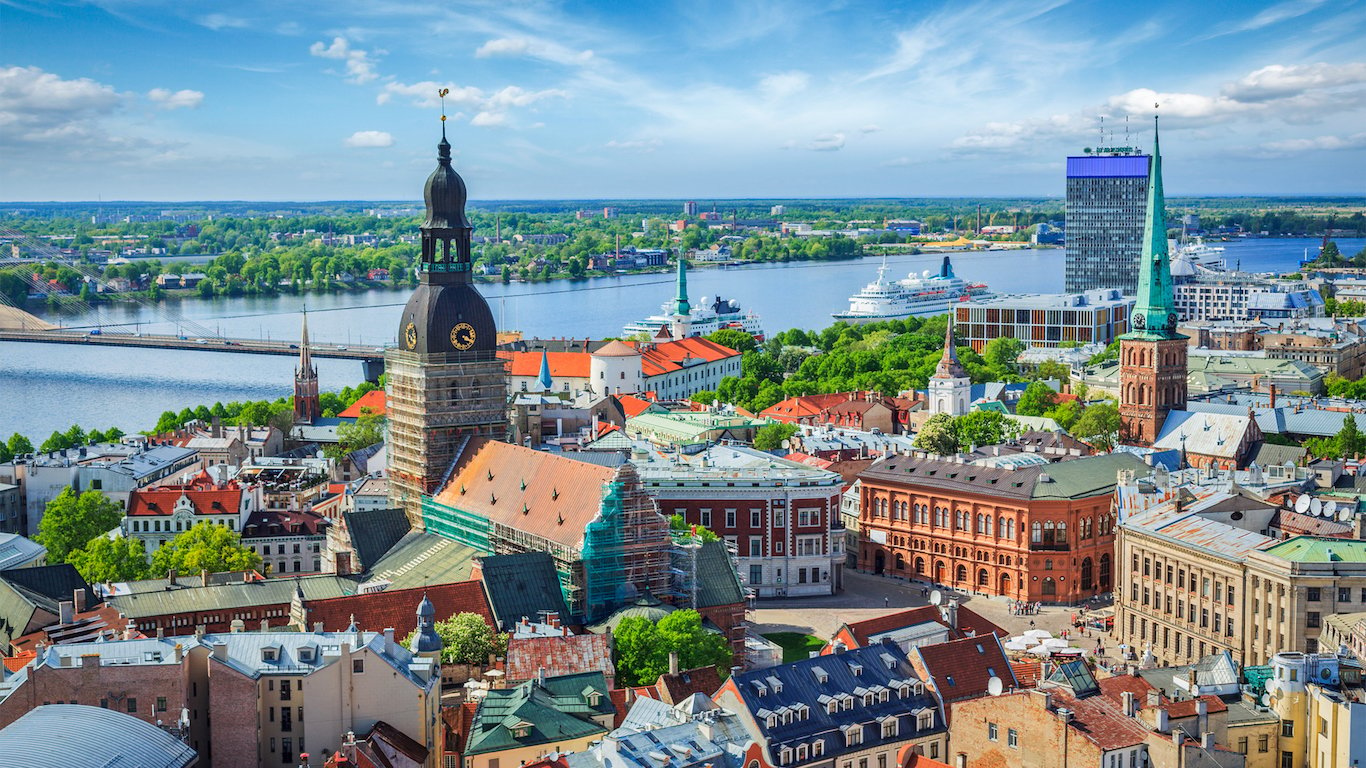
1. Latvia
> Military spending 1 yr. change: +44%
> 2016 military spending: $407.0 million
> Region: Eastern Europe
> Population: 2.0 million
Latvia spent $407.0 million on defense in 2016, a 44% increase from the year prior. The increase in military spending was part of a larger trend across Central Europe, likely in response to the Russian buildup of military strength and annexation of Crimea in 2014. Latvia plans to increase its military spending from roughly 1.1% of GDP to the 2.0% NATO recommended threshold by 2018. The three Baltic nations of Latvia, Lithuania, and Estonia are expected to spend a combined $2.1 billion on defense by 2020, more than double what the Baltic countries spent in 2004, the year they joined NATO.
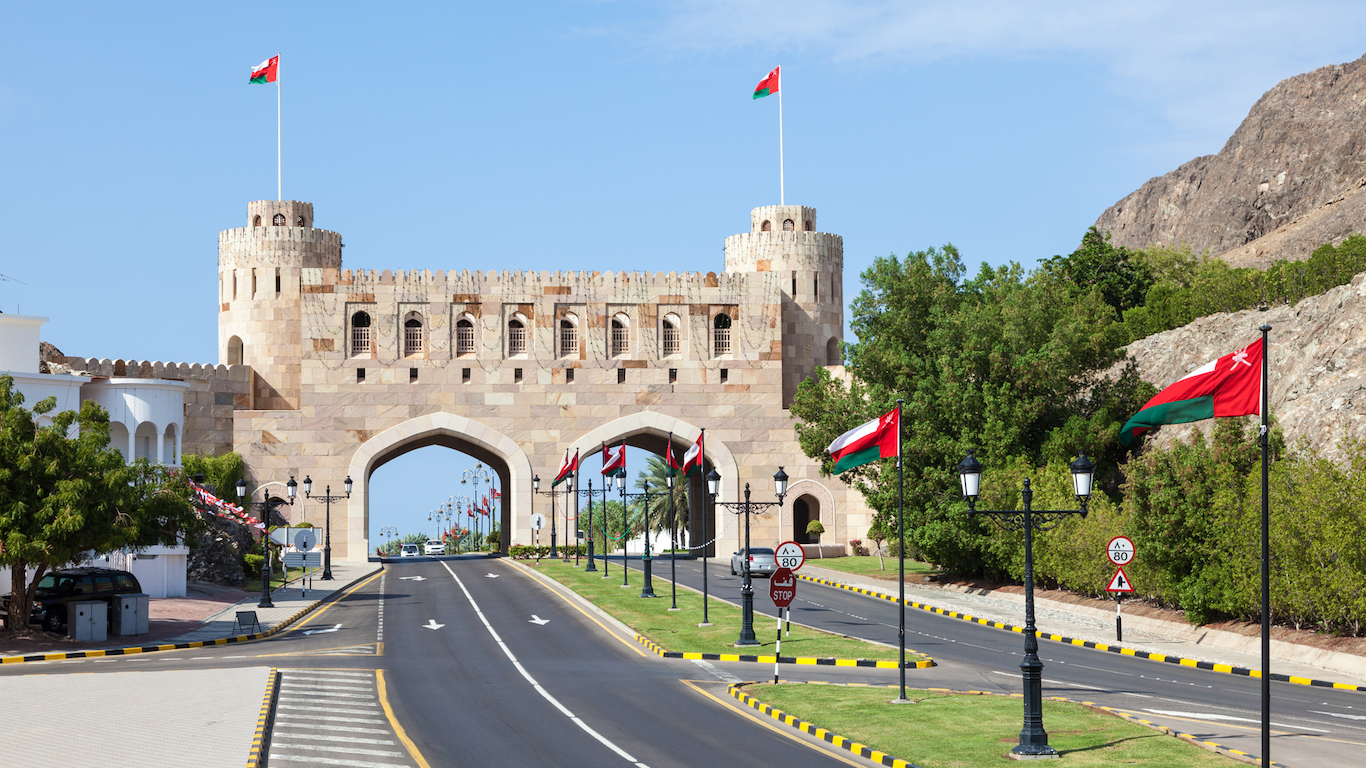
15. Oman
> Military spending 1 yr. change: -9.6%
> 2016 military spending: $9.1 billion
> Region: Western Asia
> Population: 4.5 million
Oman is one of many oil-dependent countries to decrease its military budget in 2016 in the wake of falling oil prices around the globe. Petroleum profits account for roughly 20% of Oman’s GDP, far more than the 12.6% average for countries in the Middle East and North Africa, and many times greater than the 0.8% global average. Despite the decrease, Oman’s defense budget remains equal to 17% of its GDP, the largest share of any country worldwide.
Oman joined last year the Saudi-led coalition of Muslim countries to fight militant groups in the region. While this could increase demand for military spending, such increases in the future will be unlikely unless Oman’s oil industry recovers.
[in-text-ad]
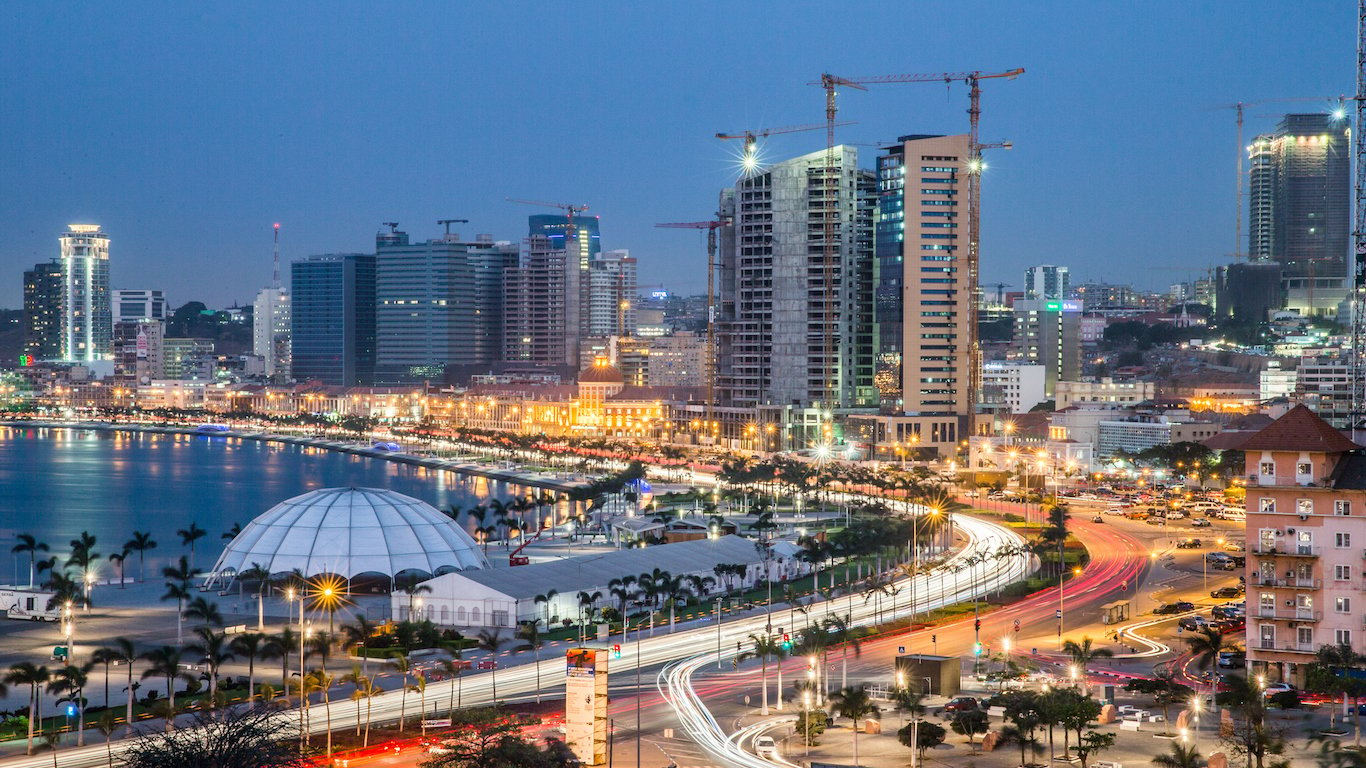
14. Angola
> Military spending 1 yr. change: -10%
> 2016 military spending: $2.8 billion
> Region: Sub-Saharan Africa
> Population: 25.0 million
Angola spent $2.8 billion on defense in 2016, 10% less than in 2015 and the same level as a decade earlier. Angola’s oil industry accounts for about 11% of the nation’s GDP, more than four times the 2.4% average for all sub-Saharan African nations. Like other oil-dependent economies in the region, Angola’s shrinking military spending is likely the result the recent plunge in global oil prices which remain at historic lows. The price of crude oil fell by roughly half from over $100 per barrel in early 2014 to just over $50 a barrel in 2017. Angola, which accounts for an estimated 15% of all defense spending in sub-Saharan Africa, contributed to the region’s 3.6% decline in military spending overall.
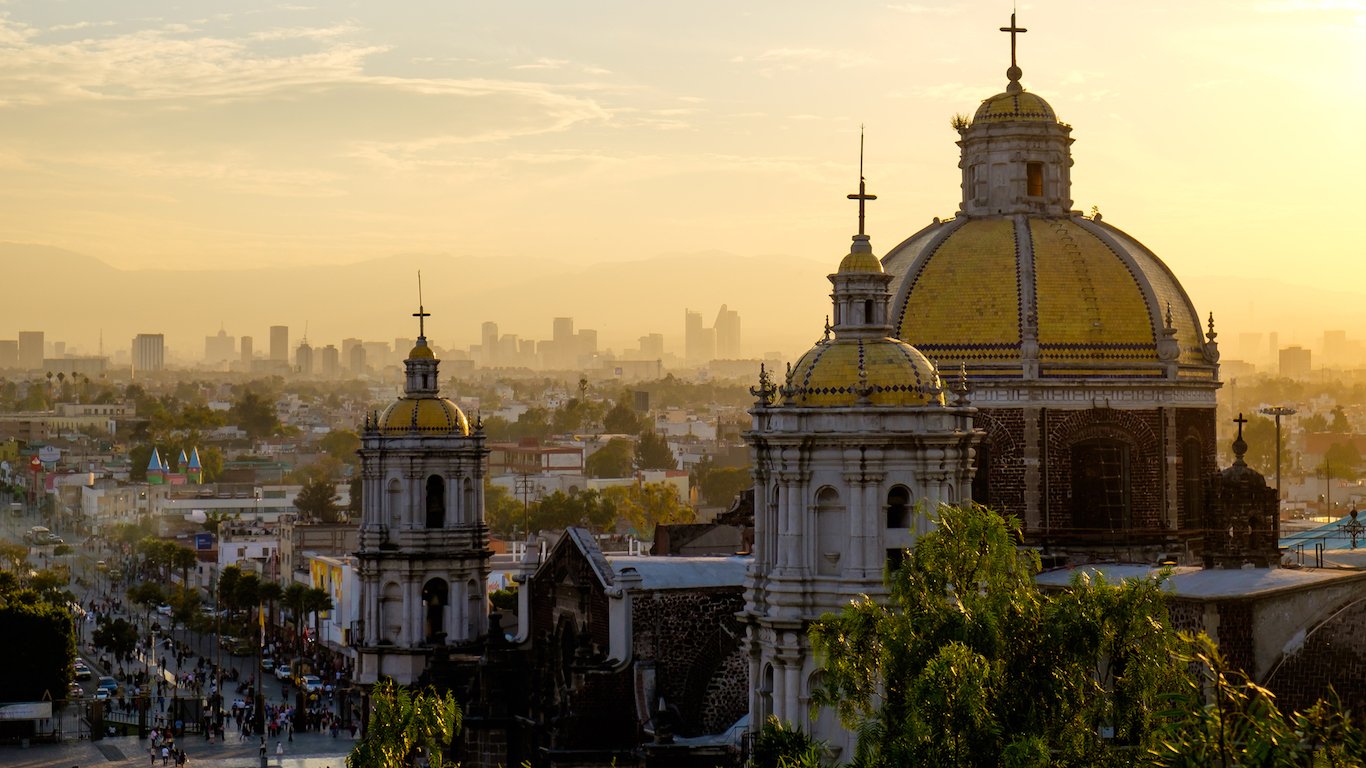
13. Mexico
> Military spending 1 yr. change: -11%
> 2016 military spending: $6.0 billion
> Region: Central America
> Population: 127.0 million
Mexico spent $6.0 billion on defense in 2016, an 11% decrease from the year before.
Mexico’s defense budget, which accounts for roughly 77% of total defense spending in Central America and the Caribbean, contributed to the region’s 9.1% decline in defense spending overall.
Mexico has actually increased its defens e budget in past years in an effort to combat violent drug cartels within the country. The country’s annual military spending declined last year for the first time since 2004. In light of low oil prices, high government debt, and substantial budget cuts proposed by the Mexican government, the country’s defense spending will likely continue to decrease in the coming years.
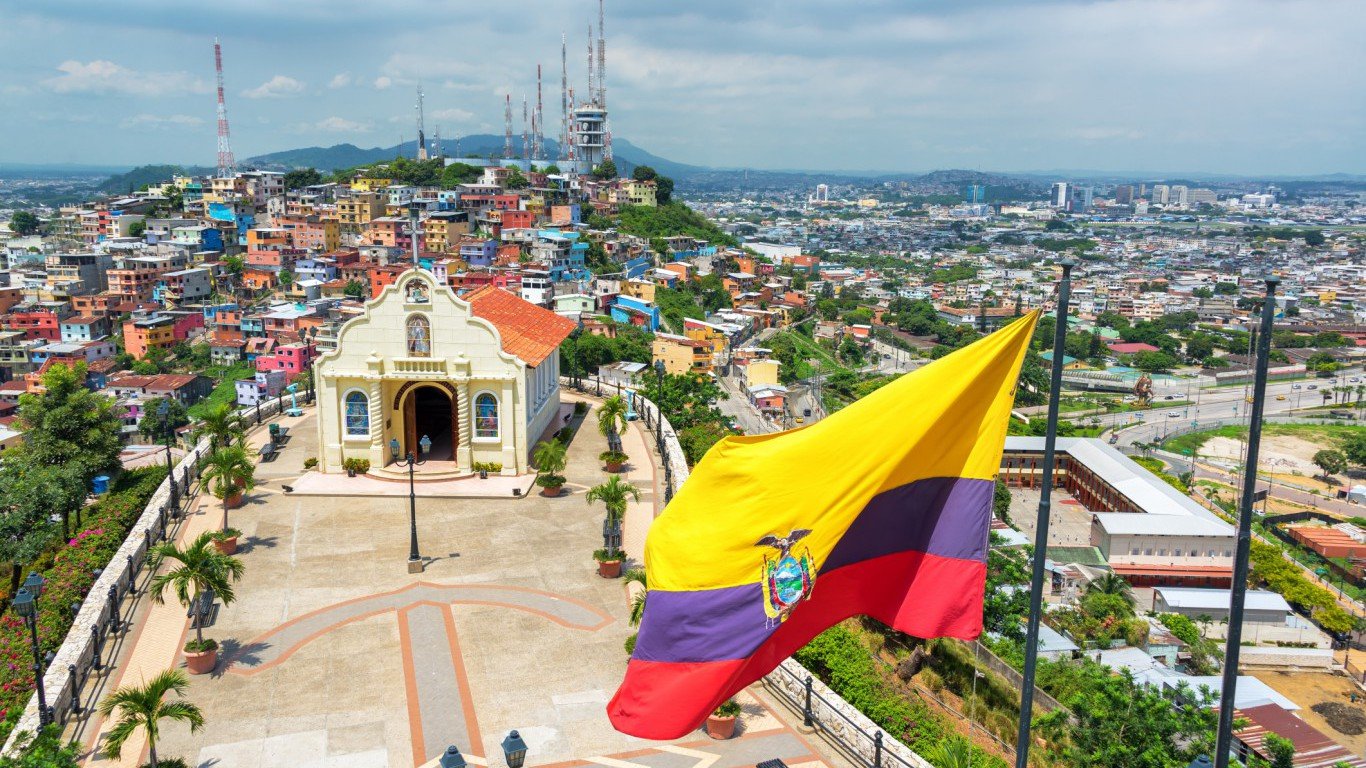
12. Ecuador
> Military spending 1 yr. change: -13%
> 2016 military spending: $2.2 billion
> Region: South America
> Population: 16.1 million
Ecuador is one of many countries with non-diversified, oil-dependent economies that have reduced military spending in the wake of falling petroleum prices. Ecuador joined OPEC in 1973 and remains one of the top oil-exporters in South America. The country’s crude oil production in 2016 was 543,100 barrels per day.
Ecuador dedicated $2.2 billion to defense in 2016, a 13% decrease from the year prior. Ecuador accounts for roughly 4% of all military spending among South American countries, and it contributed to the region’s 9.6% decline in defense spending.
[in-text-ad-2]
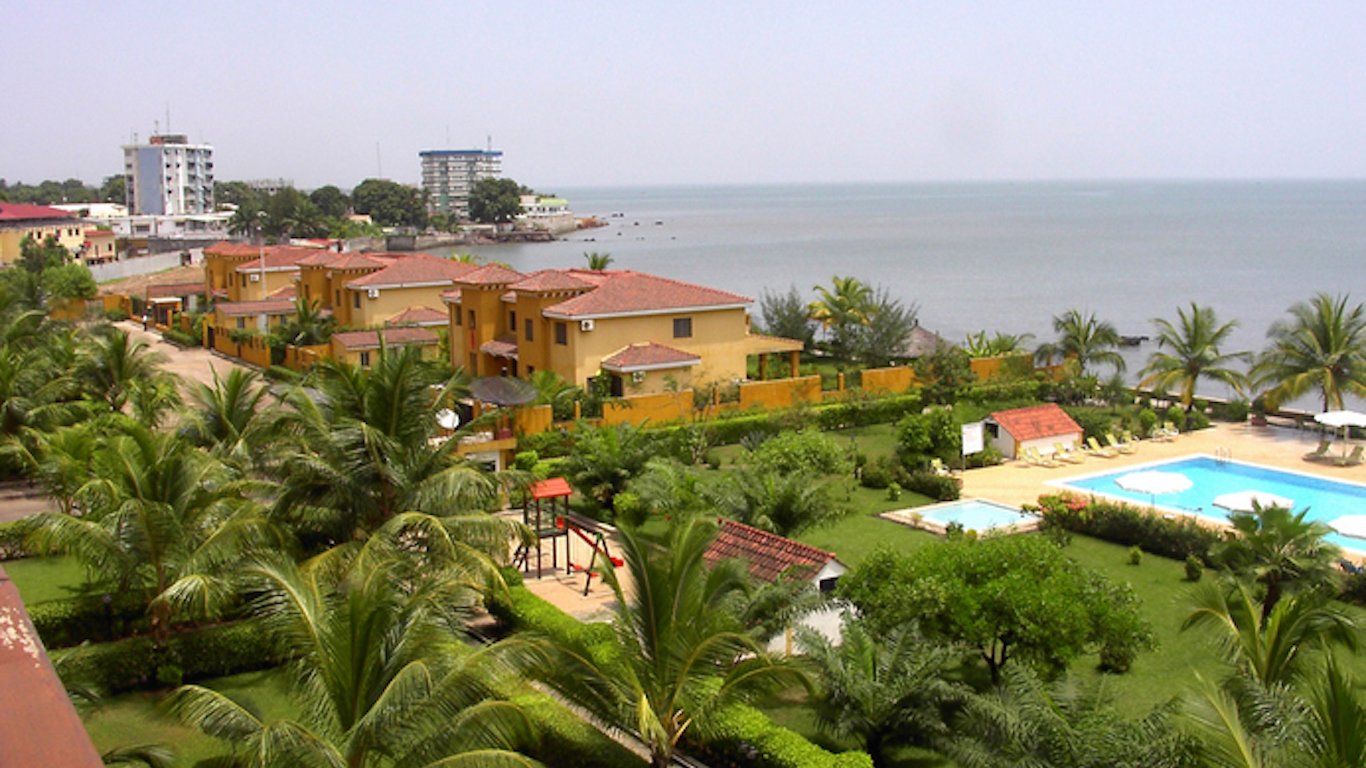
11. Guinea
> Military spending 1 yr. change: -19%
> 2016 military spending: $162.0 million
> Region: Sub-Saharan Africa
> Population: 12.6 million
Unlike nearly all of the countries with the fastest shrinking defense spending, Guinea is not a major oil exporter, and its finances have not been hurt directly by the global collapse in crude oil prices. Still, Guinea 2016 military expenditure of $162 million was down by 19% from 2015. Guinea’s decreased military spending is in line with the 3.6% average decline in military spending across all countries in sub-Saharan Africa. According to the World Bank, Guinea’s economy is currently recovering from several economic shocks, including the aftermath of Ebola, which circulated in southeastern Guinea in 2014.

10. Peru
> Military spending 1 yr. change: -20%
> 2016 military spending: $2.5 billion
> Region: South America
> Population: 31.4 million
Military expenditure across Central America, South America, and the Caribbean fell last year to levels not seen since 2007. Like other oil-exporting nations in the region, Peru’s military spending has likely declined as a result of economic crisis. Last year, Peru produced 144,000 barrels of petroleum per day. While Peru remains among the top 50 oil producers in the world, this level of production is down substantially from 2014.
Depending on regional threats, physical geography, and the priorities of government decision-makers, each country often has unique military needs. With a large coastline and an ongoing drug-trafficking problem, Peru maintains a sizable naval force.
[in-text-ad]
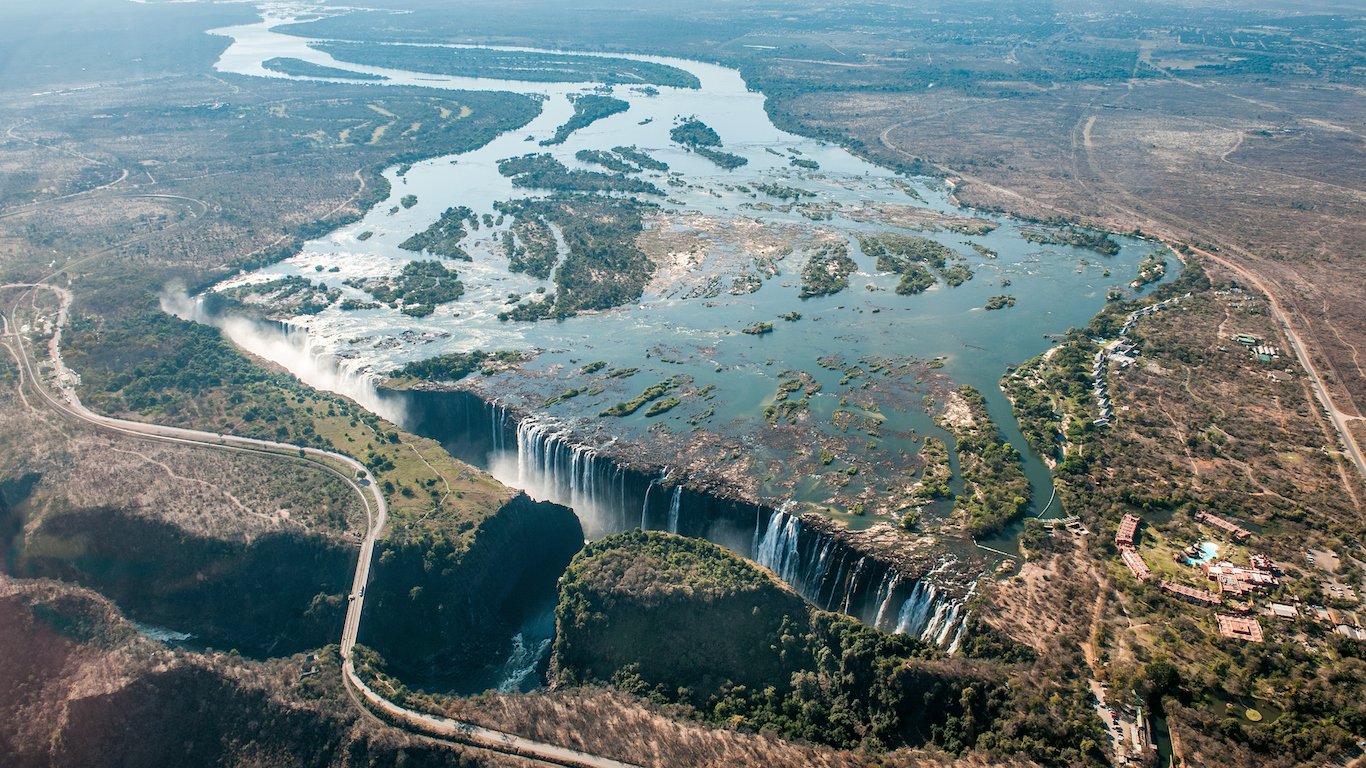
9. Zambia
> Military spending 1 yr. change: -22%
> 2016 military spending: $300.0 million
> Region: Sub-Saharan Africa
> Population: 16.2 million
Military spending declined across sub-Saharan Africa last year. Zambia, one of the biggest military spenders in the region, accounted for a substantial share of the regional decline. The country cut military spending by 22% in 2016 — one of the steepest drops of any country in the world.
Unlike many of its neighbors, Zambia is a relatively stable nation. Formerly known as Northern Rhodesia, Zambia has managed to avoid war since gaining independence from Great Britain in 1964. The country’s lasting peace may partially explain declines in military expenditure.
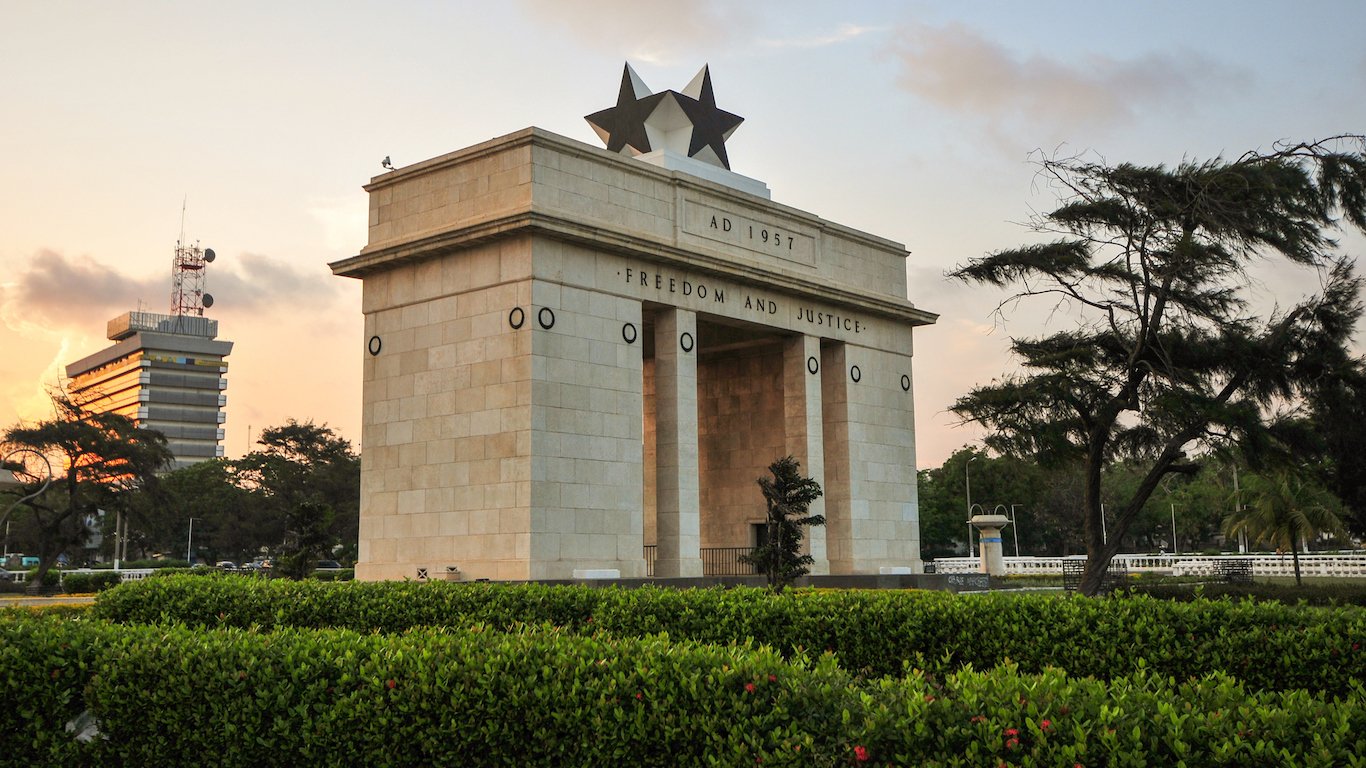
8. Ghana
> Military spending 1 yr. change: -23%
> 2016 military spending: $162.0 million
> Region: Sub-Saharan Africa
> Population: 27.4 million
Ghana spends relatively little on its military. The sub-Saharan country allocated approximately 0.49% of its GDP on military spending. By comparison, NATO member states are expected to spend at least 2.0% of GDP on their militaries. Last year, Ghana cut its total military expenditure by 23% — more than all but a handful of other countries.
The Ghana ministry of defense announced this year it would work with the French government to improve maritime security. Ghana has struggled to contain illegal fishing and piracy in the Gulf of Guinea.

7. Kazakhstan
> Military spending 1 yr. change: -26%
> 2016 military spending: $1.1 billion
> Region: Central Asia
> Population: 17.5 million
Like most of the countries reporting military spending cuts, Kazakhstan is a major oil-exporter. Crude oil accounted for nearly half of the country’s 2015 exports. The 26% cut in military spending in 2016 is likely closely tied to the country’s economic dependence on oil. The sharp drop in global oil prices in late 2014 ultimately led to decreased military spending in a number of oil-rich countries.
A former USSR member state, Kazakhstan entered into a long-term strategic partnership with the United States in late 2001.
[in-text-ad-2]
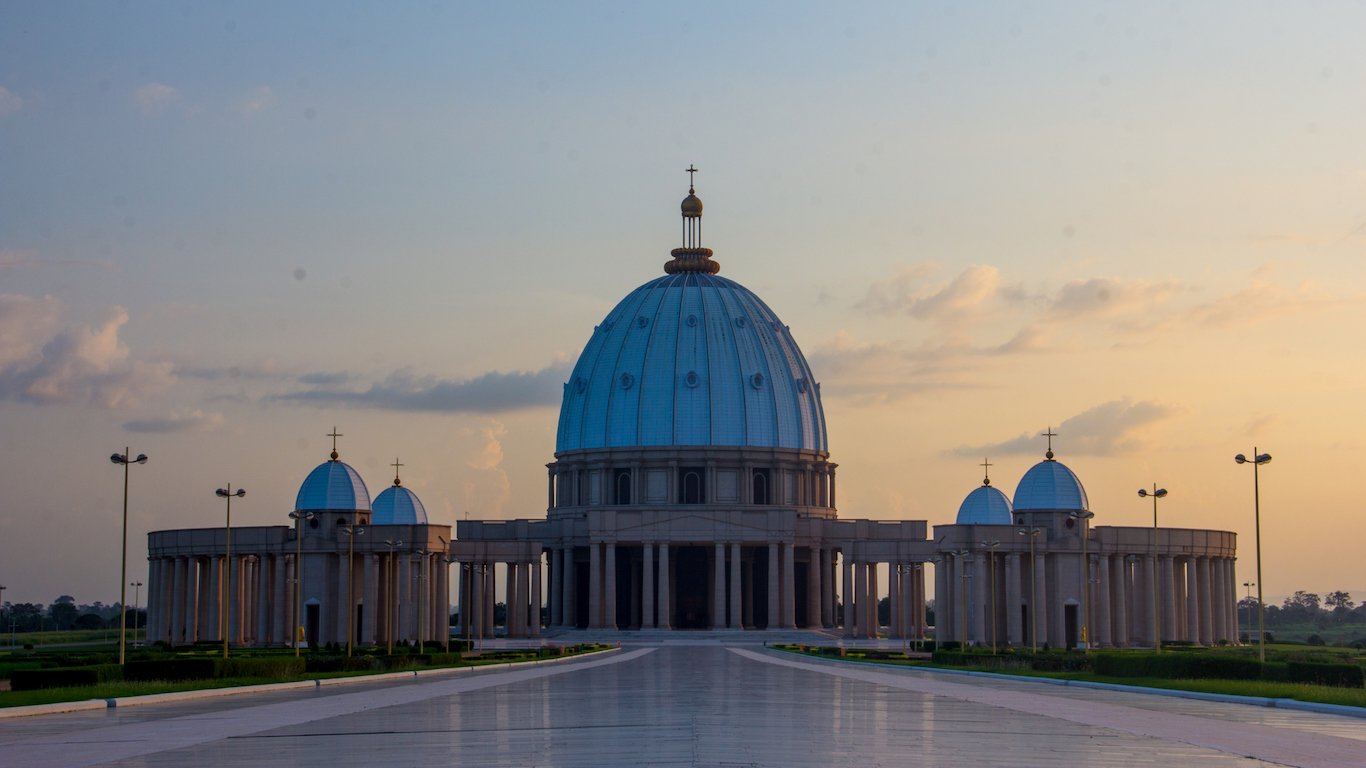
6. Côte d’Ivoire
> Military spending 1 yr. change: -27%
> 2016 military spending: $425.0 million
> Region: Sub-Saharan Africa
> Population: 22.7 million
Côte d’Ivoire, or the Ivory Coast, spent $425 million on its military last year, a 27% decline in spending from the previous year. Spending cuts were likely the result of the perceived threat of terrorism. In March of last year, Islamist militants attacked a resort town in the country, killing 18 people.
Wages for military personnel may increase and contribute to some increased spending this year. This January, the country’s president ended a two-day army mutiny by paying out bonuses and pledging to improve working conditions for the armed forces.
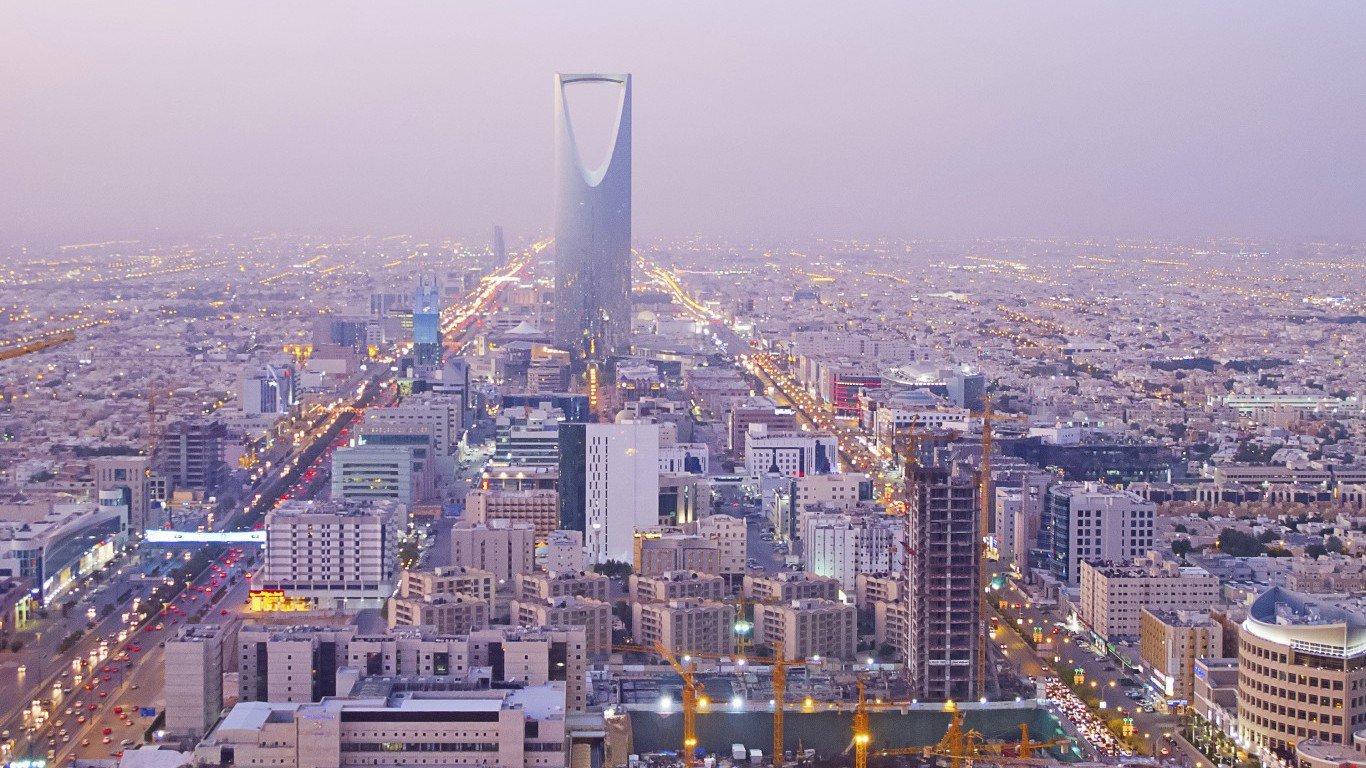
5. Saudi Arabia
> Military spending 1 yr. change: -30%
> 2016 military spending: $63.7 billion
> Region: Western Asia
> Population: 31.5 million
Saudi Arabia had the third largest military budget in the world in 2015, trailing only the U.S. and Russia. However, after a 30% decline in 2016, the oil-rich Middle Eastern country now ranks fourth in the world for military spending. Still, the country accounts for 3.8% global military expenditure.
While four other countries cut their military spending by a larger percentage, no country cut its spending by a larger dollar amount than Saudi Arabia, which spent $25.8 billion less on its military in 2016 compared to 2015. Like many other major oil exporters, the country’s military spending cuts are largely a product of declining oil revenues. Still, military spending tends to be high in the Middle East, and while the average military expenditure globally is 2.2% of GDP, Saudi Arabia’s military expenditure remains at 10% of GDP.
[in-text-ad]
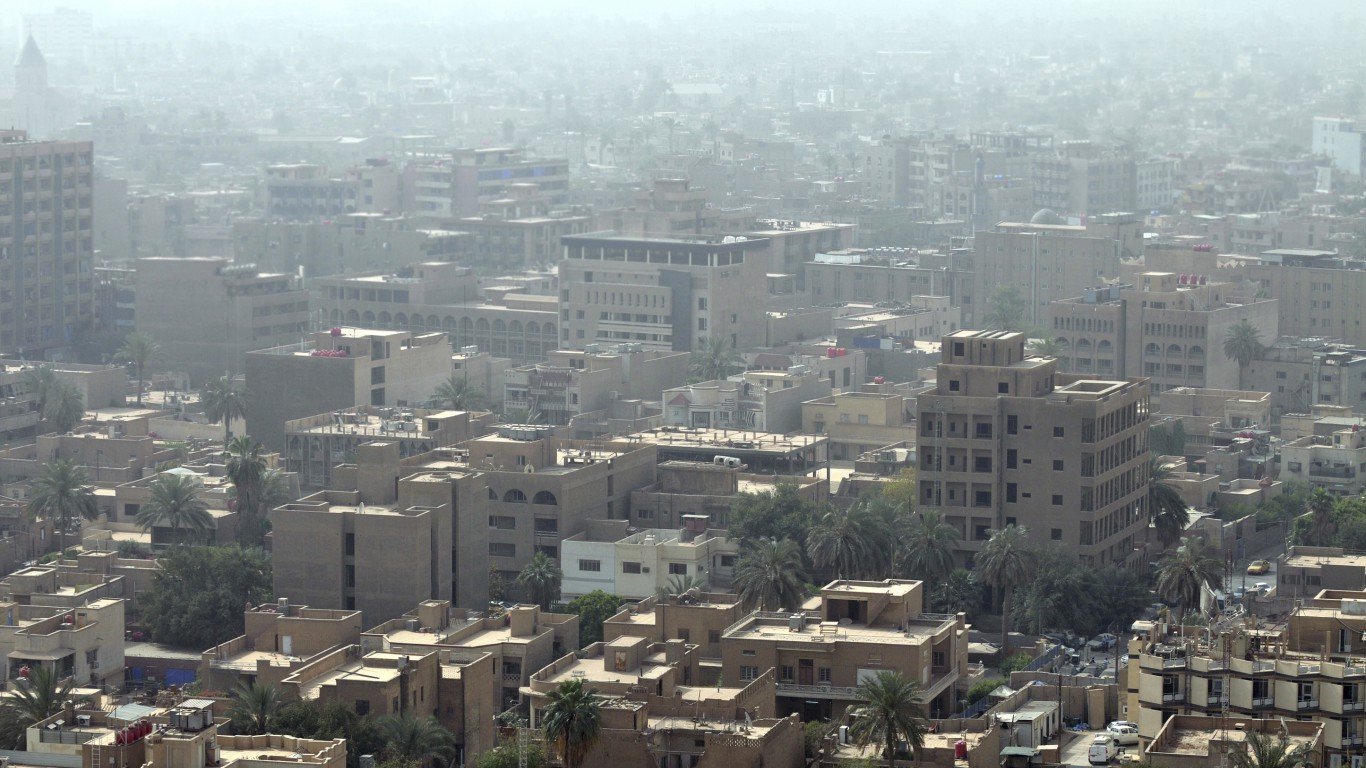
4. Iraq
> Military spending 1 yr. change: -36%
> 2016 military spending: $6.2 billion
> Region: Western Asia
> Population: 36.4 million
Iraq is one of many undiversified, oil-dependent economies that cut military spending in the wake of declining global oil prices. The price of crude oil fell by roughly half from over $100 per barrel in early 2014 to just over $50 a barrel in 2017. Oil revenue amount to 28.6% of Iraq’s GDP, far more than the 12.6% average for all Middle East and North African nations. Despite increased threat from ISIS militants, Iraq’s 2016 defense spending of $6.2 billion was down by 36% less from the year before.
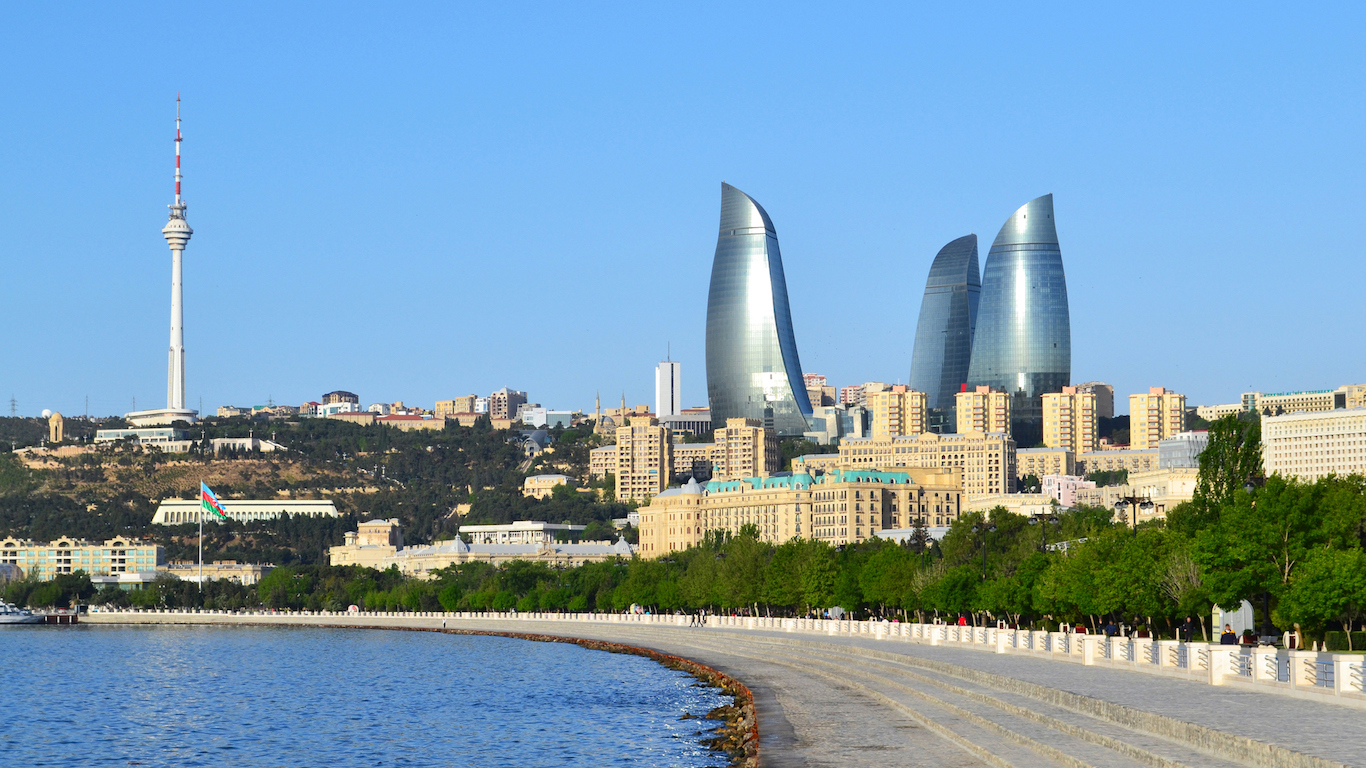
3. Azerbaijan
> Military spending 1 yr. change: -36%
> 2016 military spending: $1.4 billion
> Region: Western Asia
> Population: 9.6 million
Crude oil accounted for over 85% of Azerbaijan’s total exports in 2015. Like many oil-rich countries, steep drops in Azerbaijan’s military budget in 2016 were largely the result of declining export revenue, attributable to the falling price of oil. The country’s military spending declined by 36% last year — the largest such year-over-year spending drop since 2011.
Military spending cuts in the former Soviet state come despite ongoing military tension with neighboring Armenia.
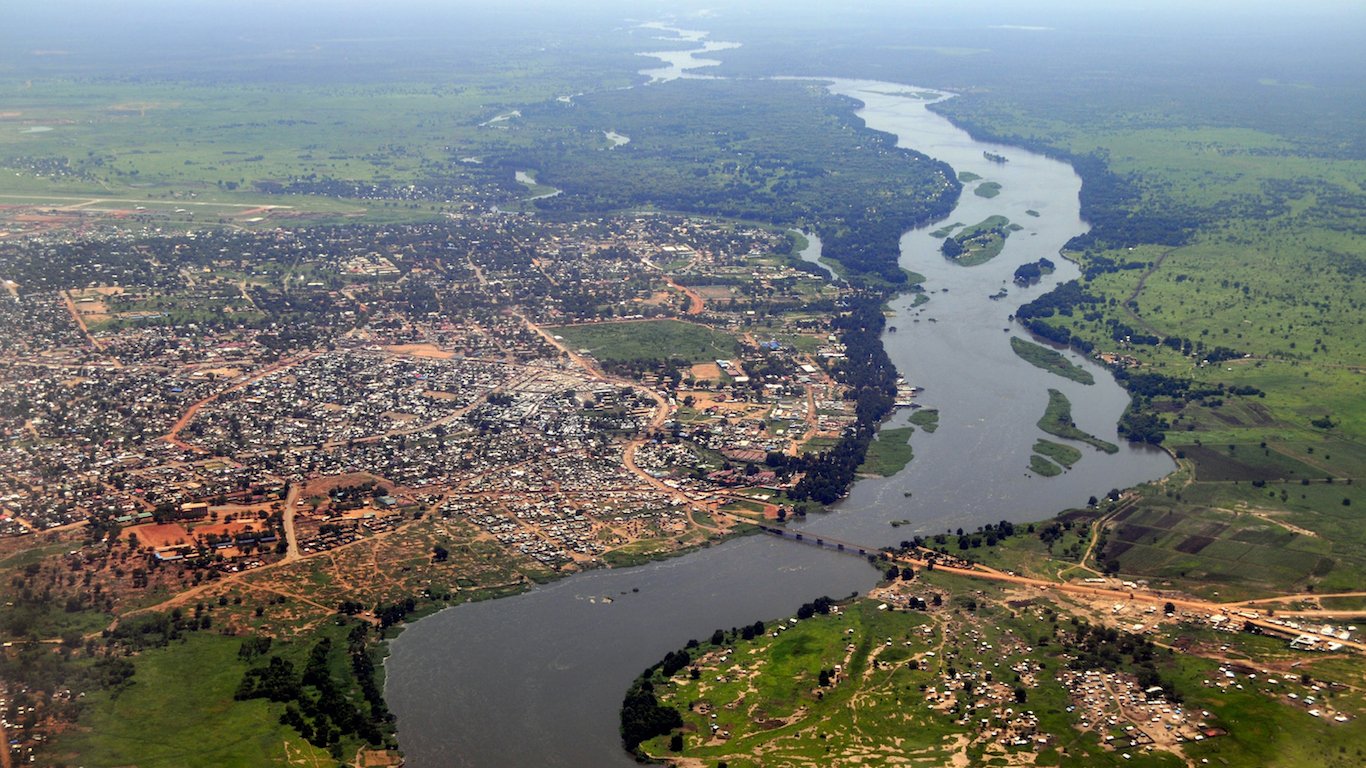
2. South Sudan
> Military spending 1 yr. change: -54%
> 2016 military spending: $138.0 million
> Region: Sub-Saharan Africa
> Population: 12.3 million
South Sudan spent $138 million on defense in 2016, 54% less than in 2015. The decline was part of an overall trend across sub-Saharan African nations, where defense spending overall fell by 3.6% last year. In addition to South Sudan, Angola, Côte d’Ivoire, Ghana, and Zambia all decreased their military spending substantially last year. The global decline in oil prices which remain near historic lows largely accounts for the defense budget cuts across the region. Oil accounts for 12.0% of South Sudan’s GDP, a much larger share than the 2.4% average for sub-Saharan Africa and 0.8% global average.
[in-text-ad-2]

1. Venezuela
> Military spending 1 yr. change: -56%
> 2016 military spending: $9.2 billion
> Region: South America
> Population: 31.1 million
Many countries on this list have cut military spending by necessity due to falling global oil prices. Venezuela is perhaps the most notable example. Heavily dependent on oil exports, the South American country is currently in a deep financial crisis. With food, medicine and basic good shortages, economic conditions forced Venezuela to cut military spending by 56% in 2016, more than any other country in the world.
Largely the consequence of the economic crisis, Venezuela is struggling with ongoing anti-government protests. President Nicolas Maduro, who is not scheduled to leave office until 2019, will likely continue to use the Venezuelan military to maintain order.
Take the quiz below to get matched with a financial advisor today.
Each advisor has been vetted by SmartAsset and is held to a fiduciary standard to act in your best interests.
Here’s how it works:
1. Answer SmartAsset advisor match quiz
2. Review your pre-screened matches at your leisure. Check out the
advisors’ profiles.
3. Speak with advisors at no cost to you. Have an introductory call on the phone or introduction in person and choose whom to work with in the future
Take the retirement quiz right here.
Thank you for reading! Have some feedback for us?
Contact the 24/7 Wall St. editorial team.